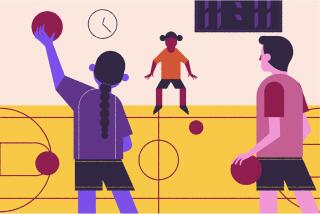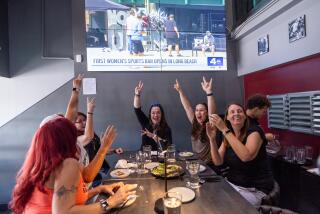Now That <i> Everyone</i> ‘s Not Participating Anymore, Once Again It’s a Good Time to Be a Tennis Player : A Boom Gone Bust? : No More Block-Long Waiting Lines Is Just Fine With Serious Players
- Share via
Remember tennis?
The encyclopedias say tennis originated with the French in the 1100s, but as any American worth his or her weight in Nielsen ratings will attest, the sport really got its start when Bobby Riggs and Billie Jean King took center court in the Houston Astrodome in 1973, and when two lovesick American kids named Chris Evert and Jimmy Connors won Wimbledon singles titles in 1974.
That’s when it began. When the pounds of tension at which you strung your racket were just as interesting as the color of your mood ring; when heated words could just as easily develop over the metal vs. wood racket controversy as the Watergate scandal. It was the mid-to-late 1970s, and tennis was the biggest thing to hit mass recreation since Woodstock.
In a 1986 survey commissioned by the United States Tennis Assn., 20.7 million Americans were estimated to be playing the sport in 1977. The public courts--parks, high schools--were jammed; private clubs sprang up overnight.
Orange County was no different. If anything, the boom was bigger here. Leading the way were places such as the Los Caballeros sports complex in Fountain Valley, which started with three courts in 1977 and increased to 45 before the decade was over.
“Usually, every one of those courts had someone playing on them,” said Mark Hirtler, head professional at Los Caballeros, which today has 30 courts--15 courts became ground floors for condominium expansion.
Public courts like the ones at TeWinkle Park in Costa Mesa offered group lessons and had waiting lines that rivaled the walk-up business for “Jaws.”
“They went for blocks and blocks long,” said Louise Smith, a daytime manager at the park’s pro shop for the past 10 years. “You were lucky to get on the waiting list.”
But by 1986, according to the same USTA survey, the number of people playing tennis had dropped to 13.5 million. Orange County was, again, no different.
Smith can fit you into a group lesson these days; the problem is the lesson may be canceled because not enough people sign up.
“Things have really changed,” she said.
Kelly Hilliard, recreation leader at Buena Park’s Boisserance Park, says that park’s courts go nearly unused.
“I think I saw a guy playing on one of them a couple of days ago,” she said. “Besides that, we don’t get a lot of people playing here.”
Soooo, what happened to tennis? Did the boom go bust?
Not really. It just kind of fizzled and leveled off. Tennis is still one of the most popular recreational activities, it’s just that everyone is not doing it anymore. That doesn’t concern people like Hirtler, who figures those who have stayed with the sport are the ones who take it seriously.
“They’re going to play tennis for the rest of their lives,” he said.
It’s a good time to be one of those people. It’s also a good time to be a person who wants to learn.
Public and private facilities are actively competing for players’ time and money, aggressively marketing where before they simply made sure the nets were free of holes.
“Maybe 10 years ago you just had to turn on the lights and people would show up. It’s a different story today,” said Brad Dorn, who works for Recreational Management Services which has contracted to run the programs for 11 Orange County cities (Anaheim, Fountain Valley, Irvine, Laguna Beach, Orange, Placentia, Santa Ana, San Clemente, Tustin, Westminster and Yorba Linda).
Dorn is the manager of Fountain Valley’s Mile Square Park facility. As is done at other RMS facilities, players at Mile Square can rent ball machines to work on ground strokes or buckets of balls to work on their serves.
“One of the biggest problems is that some people can’t find a partner to play with,” Dorn said. “So we offer things that let a player work on his game alone.”
Dorn also offers a sign-up sheet that allows individuals to match up with players of similar skills and time schedules. He says RMS’s eventual goal is to have each of the 11 cities form a giant match network blanketing the county.
Many other facilities, private and public, offer the same services. Service seems to be the name of the game these days.
It’s concerning service that private clubs have a distinct advantage over public courts. At best, a public court can offer good facilities and equipment. But those who run public courts concede that a private club usually can offer much more in the way of community. For example, a private club will offer a mixed doubles tournament for members in the morning followed by a brunch.
“People at a club see each other a lot, get to know each other, you get a feeling (that) these are your friends. Public courts can’t compete with that,” said Sally Clinard, Los Caballeros’ activities director, who pointed out that Los Caballeros is sold out of its 1,050 tennis memberships.
Said Hirtler: “I think we’re successful because we make it as easy as possible for a person who wants to play tennis to play.”
Tennis’ seemingly steep decline in popularity is in part because the sport wasn’t as easy as it looked on television. For all the things that originally attracted the masses in the mid-70s--exercise, the outdoors, designer sweat bands--one feature of the sport eluded many.
Tennis is a pretty tough game to play.
“I had these friends who started when I did back about 1976,” said Frank Hermann of Irvine. “They got all excited and went out and bought the best clothes and the best rackets. They looked great, then they found out they couldn’t play the game. I guess they thought if they dressed the part they’d play that way. It wasn’t long before they quit and tried something else.
“For myself, I really liked the game. Even though it was tough, I stuck with it. I know I’ll play it for the rest of my life.”
The decline in participation can be traced to those people who tried the sport--some who probably were trying a sport for the first time in years--and who found out that the slightest tilt of the racket’s face meant the difference between a good shot and a ball flying over the fence. Many fell away, many times into other sports such as racquetball.
“I imagine tennis is the best thing that ever happened to racquetball,” said Denise Ahart of Brea.
Ahart said she got involved with tennis in 1978, fascinated at the prospect of having a two-hand backhand just like Sweden’s Bjorn Borg. Eventually she two-handed her $60 racket into a metal net post. Now Ahart only plays racquetball for her exercise, and keeps the twisted, mangled thing as a sort of morbid reminder.
“I just couldn’t control myself,” Ahart said. “I got so frustrated. You have to hit the ball dead center or it just dies. I couldn’t take it anymore. . . . Racquetball, you still get a good workout, you don’t have to chase the ball all over the place and you don’t have to hit the ball dead center all the time. You just have to hit it.”
Attitudes such as Ahart’s don’t bother people like Tom Roice of Garden Grove a bit. Roice is 67 and says he has been playing since the 1950s. The problem wasn’t crowds then, just finding a court.
“The sport was still pretty small at the time,” he said.
Then came the ‘70s and The Boom, which brought new courts with lots of new players.
“Whenever I went to play I used to allow a half hour just to wait for a court,” he said.
It got so bad, that one day in the late ‘70s, Roice decided to hang up his Jack Kramer model.
“It just wasn’t worth it anymore.”
But two years ago, as he drove past Mile Square Park, Roice spied an incredible sight. Empty tennis courts.
“At first I thought to myself, ‘OK, they’re either being resurfaced or there’s been a bomb scare,’ ” said Roice, who plays these days with an oversized racket. “But then I saw empty courts in other cities I figured out, ‘Hey, things have changed.’ ”
They certainly have, and if you’re a player, probably for the better.
More to Read
Go beyond the scoreboard
Get the latest on L.A.'s teams in the daily Sports Report newsletter.
You may occasionally receive promotional content from the Los Angeles Times.










